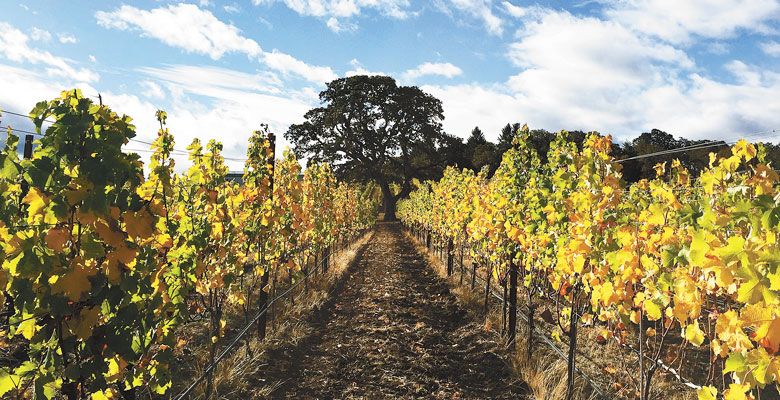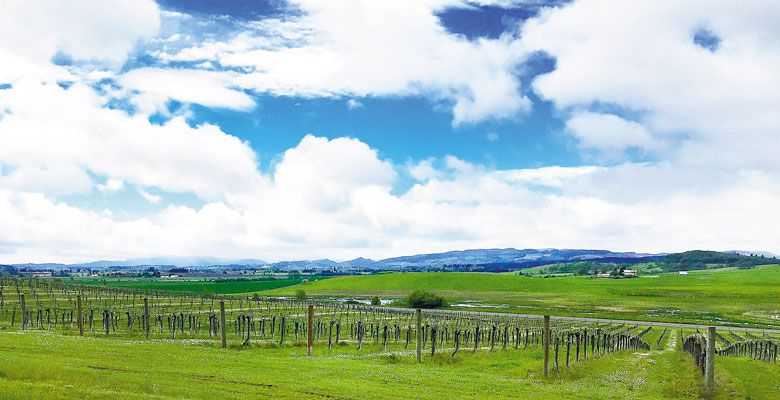A Real Van Doozy
Oregon’s next AVA a lesson in persistence
Jeff Havlin and his winemaking cohorts west of Salem have spent the past five years jumping through hoops made of red tape. Some they had to jump through twice. As a result, Oregon will have its 19th American Viticultural Area (AVA) by 2018.

Havlin, a former financial manager who taught business in China, owns the aptly named Havlin Vineyard, a 35-acre farm on Perrydale Road in Dallas. He first proposed the new AVA in 2011, forming a consortium of like-minded winemakers from the west Eola Hills to the easternmost edge of the Van Duzer Corridor. Vineyards like Firesteed, Left Coast, Eola Hills, Namasté, Huntington Hill and Van Duzer all agreed to apply for AVA status. And it looked as though they had all the elements in place: They had a defined region with a name, a unique climate, defined soil and specific elevation.
It all seemed perfect. So they filled out the paperwork and sent it to the Alcohol and Tobacco Tax and Trade Bureau and then just waited for their letter of approval.
But that’s not what happened. Instead, Havlin received a rejection letter from the TTB on the grounds the application was “deficient.” It seems the name they’d picked, Perrydale Hills, was not a nationally recognized name, even though everyone in the area knew it as such. But that was only the beginning. Apparently, they also had poorly documented climate and soil. In the meantime, Havlin said gathering all the AVA participants as a team proved almost impossible.
“We could never get a meeting going,” he said. A lot of the vineyards are owned by absentee growers who would send employees as emissaries, further diminishing the direct investment in the cause.
It had become a pain in the barrel room. But let’s start with the name. According to the regulations, a proposed AVA must have a name that has been documented through writing. This can be on a map, or a history book or a newspaper. So, Havlin set out to establish what every local knew: Perrydale Hills is a place. He called the newspapers, looking for articles referring to Perrydale Hills. Nothing. He went around and brought 17 affidavits from locals who declared they understood Perrrydale Hills as a place.
Nope. Not good enough.
So, what else could they call it? They’d tried Van Duzer already, but that one had been denied only because Chehalem Mountains AVA lays claim to parts of the corridor, but by now Havlin was not only out of ideas, he was on a first-name basis with TTB official Karen Thornton in Washington, D.C.
His time in China taught him the value of Guanxi, or “relationship” in business dealings. Perhaps by sheer repetition, he’d managed to establish some Guanxi with Thornton, and he applied an unorthodox approach to leverage this: He begged. And it worked. Thornton decided to let him have Van Duzer.
The initial obstacle had been overcome: They had a name. And so, the Van Duzer AVA, emboldened by this small success, galvanized around the cause, and Havlin managed to rally his troops. Next, they would have to tackle the climate issue. The area is unique in that a biting wind rolls in from the corridor each evening with the cold mathematical certainty of an Austrian freight train. The result, according to Havlin and his winemaker, Steve Barron, creates brilliant acidity as well as thick-skinned fruit, making for high quality wine.
But, like the name problem, they needed actual meteorological data to show Thornton. But how? As luck would have it, Karen Saul and Joe Allen at Andante Vineyards have a weather station. The pair used their equipment to compare weather patterns with those of Salem and McMinnville, and were able to demonstrate a unique climate.
“Without their weather data, we would have been in deep,” said Havlin.
So, two down. Next was soil. Another member of Team Van Duzer AVA, Kaitlin Björnson, stepped up with three years’ worth of soil sample data for the proposed AVA. And with the elevation and the boundaries easily defined, Havlin and his team were ready to resubmit their application. By now, he was calling Thornton at home.
“I’ve never met her; I don’t know what she even looks like, but we were on a first name basis,” he said.
On July 15, 2015, Team Van Duzer AVA finally resubmitted the application, this time with all the required elements in place.
“Karen told me this time everything looked good, and that we would know in two years,” he said.
Two years?
“They were short staffed,” said Barron. “That’s what she told us.”
Since that conversation, however, Havlin said the time frame has been compressed to just 18 months. Indeed, the finish line is in sight. They will have their AVA.
The new status will not only bring satisfaction, but a product from a recognized and unique growing area, letting Havlin and his fellow AVAers sell their fruit for better prices, and brand their wines a notch or two higher.
But Havlin makes sure to give the credit to his team, who he said all came together for the big win, making the AVA success possible.
He also adds there’s an irony at the end of this tale: Not one of the vineyards is within the Van Duzer Corridor. As we’ve already covered, all the vineyards are in Perrydale Hills, but not a sentence has been written about it. Of course, the corridor funnels all that wonderful cold air into Perrydale Hills, so maybe it’s fitting that Van Duzer will be the namesake. And anyway, Havlin says Perrydale — er — Van Duzer is an up-and-coming appellation.
In the years before Neil Zawicki landed in the Willamette Valley, he spent his time as a reporter in Alaska, and a sailor with an address in a California marina. In his spare time, he’s a student of history, a painter and a guitar player.










